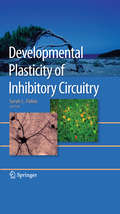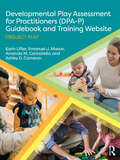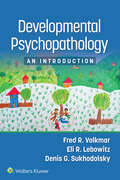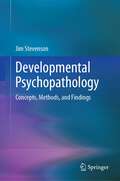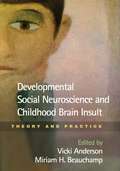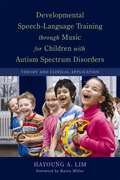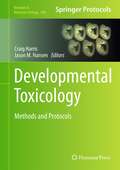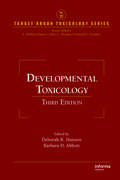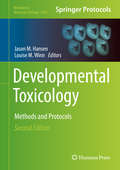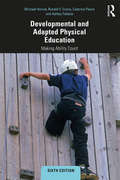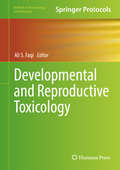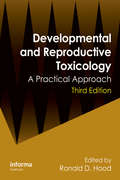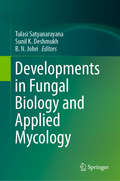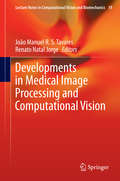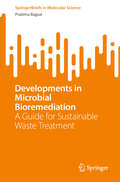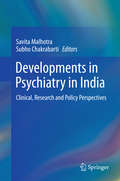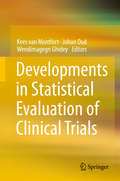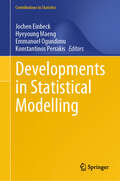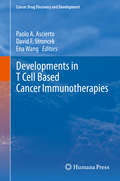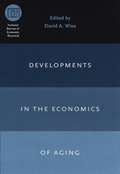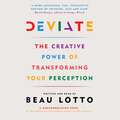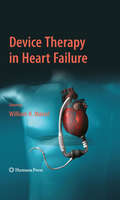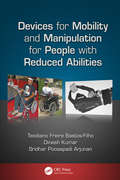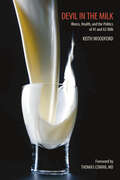- Table View
- List View
Developmental Plasticity of Inhibitory Circuitry
by Sarah L. PallasNeuroscience has long been focused on understanding neural plasticity in both development and adulthood. Experimental work in this area has focused almost entirely on plasticity at excitatory synapses. A growing body of evidence suggests that plasticity at inhibitory GABAergic and glycinergic synapses is of critical importance during both development and aging. The book brings together the work of researchers investigating inhibitory plasticity at many levels of analysis and in several different preparations. This topic is of wide relevance across a number of different areas of research in neuroscience and neurology. Medical problems such as epilepsy, mental illness, drug abuse, and movement disorders can result from malfunctioning inhibitory circuits. Further, the maturation of inhibitory circuits may trigger the onset of critical periods of neural circuit plasticity, raising the possibility that such plastici periods could be reactivated for medical benefit by manipulating inhibitory circuitry.
Developmental Play Assessment for Practitioners (DPA-P) Guidebook and Training Website: Project Play
by Karin Lifter Emanuel J. Mason Amanda M. Cannarella Ashley D. CameronDevelopmental Play Assessment for Practitioners (DPA-P) Guidebook and Training Website: Project Play offers a comprehensive assessment of naturally occurring play activities for evaluating young children’s developmental progress accurately, so that useful interventions can take place as early as possible. It can be used by practitioners in a wide range of educational and therapeutic settings and is designed to support developmental progress through planning interventions in play, and using what we know about a child’s progress in play to plan play-based interventions in cognition, language, motor, social-emotional, and self-help skills. The guidebook and training website provide a comprehensive introduction to how to successfully use the assessment with infants, toddlers, and young children with disabilities or at risk for disabilities. The comprehensive guidebook offers an overview of the DPA-P and Project Play, defines play, discusses the background literature on play, and explains why this assessment is needed. Clear guidance helps practitioners and family members understand play, how to evaluate play, and how to use play for different purposes. The guidebook offers: an introduction to the comprehensive training website and how to use it understanding of the categories of play assessed and their definitions guidance on how to administer the assessment and prepare a summary evaluation of a child’s performance clear instructions for the coding sheets and scoring guidelines for constructing sets of toys guidance on taking the results of the DPA-P evaluation of a child’s progress in play to develop a plan of activities for intervention explanation of how you evaluate activities at the absence, basic, emergence, and mastery levels for developing a plan suggestions for assembling sets of toys for intervention, based on toys available in children’s homes and early childhood settings procedures for facilitating or teaching play activities to children who are developing more slowly than their peers technical aspects of the assessment To make the DPA-P as flexible as possible for all practitioners, it also offers guidance on adaptations for administering the test, in the coding sheets, with toys to enhance cultural appropriateness for gathering the observations, and for supporting interventions in play. The Developmental Play Assessment for Practitioners (DPA-P) can be used in natural settings and takes 30 minutes to complete. It is a valuable tool for all those who serve, or are training to serve, young children in early childhood settings, schools, service agencies, colleges, and universities. It will be of great benefit for early intervention personnel, speech-language pathologists, physical therapists, occupational therapists, and psychologists.
Developmental Psychopathology: An Introduction
by Fred R. Volkmar Eli R. Lebowitz Denis G. SukhodolskySpecifically designed for readability and utilizing a concise format, Developmental Psychopathology: An Introduction offers an authoritative, approachable overview of mental developmental disorders and problems faced by children and adolescents. Noted researcher and author Dr. Fred R. Volkmar leads a team of experts from the Child Study Center at Yale University School of Medicine in presenting essential, introductory information ideal for fellows and physicians in child and adolescent psychiatry, as well as psychiatry residents and other health care professionals working in this complex field.
Developmental Psychopathology: Concepts, Methods, and Findings
by Jim StevensonThis book addresses the question of whether or not behavioural differences between children can be most appropriately characterised by dimensions of psychological problems or by categorical diagnoses. It describes the concepts and methods that have been developed and applied within developmental psychopathology using this dimensional approach. The book reviews evidence on the interplay between genes and the environment in influencing internalising problems, externalising problems, Attention Deficit Hyperactivity Disorder (ADHD) and Autism Spectrum Disorder (ASD), and on the hierarchical factor structure underlying these behavioural dimensions. It provides an appraisal of the state of knowledge on the longer-term sequelae of these problems and on the efficacy of treatments that have been developed for them.Key areas of coverage include:Multivariate data analytic methods for investigating behavioural differences (e.g., path analysis, cluster analysis, structural equation modelling, network analysis) and their associated theoretical frameworks (e.g., hierarchical factor models).Methods to investigate the biology of behavioural differences (e.g., quantitative and molecular genetics, epigenetics, and brain imaging).The design of research studies that can test most directly for causality (i.e., randomised controlled trials) and others that can estimate plausible causal relationships from associations and correlations.Reviews of studies that have applied these methods to understand the developmental course of internalising and externalising behaviours and the neurodevelopmental problems of Attention Deficit Hyperactivity Disorder (ADHD) and Autism Spectrum Disorder (ASD). Developmental Psychopathology is an essential reference for researchers, professors, and graduate students as well as clinicians and other professionals in developmental psychology, clinical child and school psychology, child and adolescent psychiatry, paediatrics, clinical social work, public health, educational psychology, and all related disciplines.
Developmental Social Neuroscience and Childhood Brain Insult
by Vicki Anderson Miriam H. BeauchampSynthesizing cutting-edge knowledge from multiple disciplines, this book explores the impact of acquired brain injury and developmental disabilities on children's emerging social skills. The editors present an innovative framework for understanding how brain processes interact with social development in both typically developing children and clinical populations. Key issues in assessment are addressed, including ways to measure both social function and brain function using developmentally sound tools. Balancing theoretical and clinical concerns, the book describes promising interventions for promoting children's adjustment and helping them participate more fully in the social world. Illustrations include six color plates.
Developmental Speech-Language Training through Music for Children with Autism Spectrum Disorders
by Hayoung A. LimSpeech and language impairments are one of the most challenging features of Autism Spectrum Disorders (ASD). Children with ASD are also known to be particularly responsive to music. This book makes a valuable connection between the two traits to showcase music as an effective way of enhancing the speech and language skills of children with ASD. This is a comprehensive guide to Dr. Hayoung Lim's highly effective approach of using music in speech-language training for children ASD. Part I provides a sound theoretical foundation and employs the most up-to-date research, including the author's own extensive study, to validate the use of music in speech and language training for children with ASD. Part II analyzes the clinical implications of "Developmental Speech- Language Training through Music" (DSLM) protocols and explains in detail specific interventions that can be used with the approach. The practical application of DSLM to Applied Behavior Analysis (ABA) Verbal Behavior (VB) approaches is also explored. This is essential reading for music therapists, speech and language pathologists and other professionals working with children with autism, as well as researchers and academics in the field.
Developmental Toxicology
by Craig Harris Jason M. HansenThe discipline of developmental toxicology is an integration of concepts, models, and methodologies based heavily on the superimposition of toxicology principles upon the science of developmental biology. The science of developmental toxicology also borrows from other research areas that are concerned with regulation of cell growth, migration, differentiation and cell death, as such are central to the study of stem cells, cancer, and chronic diseases. In Developmental Toxicology: Methods and Protocols expert researchers in the field detail many of the methods which are now commonly used to study developmental toxicology highlighting the evolution of methods from classical teratology approaches to the dynamic, state-of-the-art molecular methods, systems biology, and next generation models and procedures. Written in the highly successful Methods in Molecular BiologyTM series format, chapters include introductions to their respective topics, lists of the necessary materials and reagents, step-by-step, readily reproducible laboratory protocols, and key tips on troubleshooting and avoiding known pitfalls. Authoritative and practical, Developmental Toxicology: Methods and Protocols is a valuable resource to those planning experiments to investigate consequences of environmental, nutritional, or chemical effects caused during development.
Developmental Toxicology (Target Organ Toxicology Series)
by Deborah K. Hansen Barbara D. AbbottHighlighting latest advances in genetics and biochemistry, the completely revised Third Edition reviews the field from basic science, clinical, epidemiological, and regulatory perspectives. Contributions from top opinion leaders in the field bring together developments in molecular embryology and cell biology as they apply to problems in developmen
Developmental Toxicology: Methods and Protocols (Methods in Molecular Biology #1965)
by Jason M. Hansen Louise M. WinnThis thorough edition explores numerous methodological approaches that can be extremely informative for our understanding of the developmental toxicant mechanisms, characterization of developmental outcomes, and development of potential interventions that are clinically relevant. Presenting both staple and state-of-the-art approaches, the book focuses on numerous cellular models (induced pluripotent stem cells, neural crest culture, etc.), some less frequently used but important animal models (chick, zebrafish), in vitro approaches using whole embryos (rat, mouse and rabbit), and specific outcome methodologies to assess changes on the morphological to molecular level. Written for the highly successful Methods in Molecular Biology series, chapters include the kind of detail and expert implementation advice that allows for smooth processes in the lab. Authoritative and practical, Developmental Toxicology: Methods and Protocols, Second Edition serves as an ideal aid to support further investigation into the specific mechanisms and outcomes of developmental exposures.
Developmental and Adapted Physical Education: Making Ability Count
by Michael Horvat Ronald V. Croce Caterina Pesce Ashley Eason FallaizeNow in a fully revised and updated 6th edition, reflecting changes in legislation and cutting-edge research, this is a complete introduction to adapted physical education, from the underpinning science to practical teaching strategies and program design. The book covers a broader range of disabilities, developmental disorders, and health conditions than any other textbook and includes brand new material on developmental coordination disorders and cognitive development. Full of teaching and coaching strategies and techniques, it introduces scientific fundamentals, key legislation, and best practice in designing effective programs. It encourages the reader to consider the individual before the disability and to focus on what learners can do rather than what they can’t. This is an essential reference for teachers, coaches, or exercise professionals working with children with disabilities. It is also an invaluable resource for undergraduate or postgraduate students of adapted physical education, kinesiology, physical education, physical therapy, exercise science, athletic training, or sports coaching. The new edition features updated online resources, including PowerPoint slides, web links, an example syllabus, and quizzes.
Developmental and Reproductive Toxicology
by Ali S. FaqiThis meticulous volume covers metabolism and drug-drug interactions during pregnancy, critical periods of developmental toxicology, in vivo and alternative methods to assess potential developmental toxicity for drugs and chemicals, and effects of chemicals on testes and mammary glands. Evaluation of developmental and reproductive toxicology endpoints is an integral part of the safety assessment process for compounds with potential use in women of childbearing age or females that might be exposed during pregnancy as well as men of reproductive potential. The in vivo assessments included here are guideline-driven and are required for submissions for product approval. Written for the Methods in Pharmacology and Toxicology series, this collection includes the kind of detailed implementation advice necessary for success in the lab. Authoritative and practical, Developmental and Reproductive Toxicology is an ideal resource for researchers working in this vital field of study.
Developmental and Reproductive Toxicology: A Practical Approach
by Ronald D. HoodCompletely revised and updated, Developmental and Reproductive Toxicology: A Practical Approach, Second Edition draws together valuable information typically scattered throughout the literature, plus some not previously published, into one complete resource. In addition to the traditional aspects of developmental toxicity testing, the book covers e
Developmental, Physiological, and Functional Neurobiology of the Inner Ear (Neuromethods #176)
by Andrew K. GrovesThis volume explores the latest techniques in inner ear development, analysis of its sensory cells, and characterization and manipulation of the central auditory and vestibular pathways. The chapters in this book cover topics such as dissection and imaging of the cochlea; behavioral evaluation of animal models of diseases like tinnitus; hair cell function and regeneration; and recent advances in sequencing technology. In the Neuromethods series style, chapters include the kind of detail and key advice from the specialists needed to get successful results in your laboratory. Cutting-edge and comprehensive, Developmental, Physiological, and Function Neurobiology of the Inner Ear is a valuable resource for scientists and researchers interested in learning more about this developing field.
Developments in Fungal Biology and Applied Mycology
by Tulasi Satyanarayana Sunil K. Deshmukh B. N. JohriThis book explores the developments in important aspects of fungi related to the environment, industrial mycology, microbiology, biotechnology, and agriculture. It discusses at length both basic and applied aspects of fungi and provides up-to-date laboratory-based data. Of the estimated three million species of fungi on Earth, according to Hawksworth and coworkers, more than 100,000 have been described to date. Many fungi produce toxins, organic acids, antibiotics and other secondary metabolites, and are sources of useful biocatalysts such as cellulases, xylanases, proteases and pectinases, to mention a few. They can also cause diseases in animals as well as plants and many are able to break down complex organic molecules such as lignin and pollutants like xenobiotics, petroleum and polycyclic aromatic compounds. Current research on mushrooms focuses on their hypoglycemic, anti-cancer, anti-pathogenic and immunity-enhancing activities. This ready-reference resource on various aspects of fungi is intended for graduate and post-graduate students as well as researchers in life sciences, microbiology, botany, environmental sciences and biotechnology.
Developments in Medical Image Processing and Computational Vision
by João Manuel R. S. Tavares Renato Natal JorgeThis book presents novel and advanced topics in Medical Image Processing and Computational Vision in order to solidify knowledge in the related fields and define their key stakeholders. It contains extended versions of selected papers presented in VipIMAGE 2013 - IV International ECCOMAS Thematic Conference on Computational Vision and Medical Image, which took place in Funchal, Madeira, Portugal, 14-16 October 2013. The twenty-two chapters were written by invited experts of international recognition and address important issues in medical image processing and computational vision, including: 3D vision, 3D visualization, colour quantisation, continuum mechanics, data fusion, data mining, face recognition, GPU parallelisation, image acquisition and reconstruction, image and video analysis, image clustering, image registration, image restoring, image segmentation, machine learning, modelling and simulation, object detection, object recognition, object tracking, optical flow, pattern recognition, pose estimation, and texture analysis. Different applications are addressed and described throughout the book, comprising: biomechanical studies, bio-structure modelling and simulation, bone characterization, cell tracking, computer-aided diagnosis, dental imaging, face recognition, hand gestures detection and recognition, human motion analysis, human-computer interaction, image and video understanding, image processing, image segmentation, object and scene reconstruction, object recognition and tracking, remote robot control, and surgery planning. This volume is of use to researchers, students, practitioners and manufacturers from several multidisciplinary fields, such as artificial intelligence, bioengineering, biology, biomechanics, computational mechanics, computational vision, computer graphics, computer science, computer vision, human motion, imagiology, machine learning, machine vision, mathematics, medical image, medicine, pattern recognition, and physics.
Developments in Microbial Bioremediation: A Guide for Sustainable Waste Treatment (SpringerBriefs in Molecular Science)
by Pratima BajpaiThis book sheds new light on the transformative role of microorganisms in waste management, offering a comprehensive overview of microbial waste management strategies and their applications. Through this book, readers will learn about the latest advancements in bioremediation and microbial consortia technology, providing a fresh perspective on sustainable waste treatment solutions. The chapters cover topics such as the types and origins of waste, the importance of microorganisms in various waste management processes, and the benefits of bioremediation compared to traditional methods. Readers will discover diverse strategies for managing microbial waste, including bioleaching, bioaugmentation, and utilizing microorganisms to aid phytoremediation. The book also discusses the combined use of bacteria and microalgae for wastewater treatment and emerging innovations in microbial consortia technology. Critical attention is given to the role of microbes in multiple industrial applications such as pharmaceuticals, food processing, textiles, explosives, distilleries, and petrochemicals. Additionally, it explores bioinformatics approaches like genomics and proteomics that drive bioremediation efforts. This volume is an essential resource for researchers in environmental science, biotechnology professionals focusing on sustainable practices, scholars studying advanced wastewater treatment methods using nanotechnology or plant species integration with microorganisms. It invites readers to think through critical questions about sustainable waste treatment practices while offering valuable insights into future perspectives on microbial waste management.
Developments in Psychiatry in India
by Savita Malhotra Subho ChakrabartiThe volume evaluates major developments in psychiatry in India from the 1950s, and highlights the areas where Indian psychiatry has contributed to the development of the subject worldwide. The chapters review international as well as Indian developments in psychiatry and its sub-specialities. A wide range of clinical, research and policy-related topics have been covered in the volume, which begins with an overview of the history of psychiatry in India, moving on to developments in various sub-specialities of psychiatry in the last 60 years or so. It then specifically discusses developments in psychology and psychodynamics, general adult and child psychiatry, substance use psychiatry, community psychiatry, liaison psychiatry, and other psychiatric sub-specialities. Developments in treatment, the status of training and service in psychiatry and legal issues related to the practice of psychiatry in India are also included. The contributors to this volume are nationally and internationally recognized experts in different areas of psychiatry. Most of them have had some association, or are currently associated, with the Department of Psychiatry at the Post Graduate Institute of Medical Education and Research, Chandigarh, India.
Developments in Statistical Evaluation of Clinical Trials
by Kees Van Montfort Johan Oud Wendimagegn GhideyThis book describes various ways of approaching and interpreting the data produced by clinical trial studies, with a special emphasis on the essential role that biostatistics plays in clinical trials. Over the past few decades the role of statistics in the evaluation and interpretation of clinical data has become of paramount importance. As a result the standards of clinical study design, conduct and interpretation have undergone substantial improvement. The book includes 18 carefully reviewed chapters on recent developments in clinical trials and their statistical evaluation, with each chapter providing one or more examples involving typical data sets, enabling readers to apply the proposed procedures. The chapters employ a uniform style to enhance comparability between the approaches.
Developments in Statistical Modelling (Contributions to Statistics)
by Jochen Einbeck Hyeyoung Maeng Emmanuel Ogundimu Konstantinos PerrakisThis volume on the latest developments in statistical modelling is a collection of refereed papers presented at the 38th International Workshop on Statistical Modelling, IWSM 2024, held from 14 to 19 July 2024 in Durham, UK. The contributions cover a wide range of topics in statistical modelling, including generalized linear models, mixture models, regularization techniques, hidden Markov models, smoothing methods, censoring and imputation techniques, Gaussian processes, spatial statistics, shape modelling, goodness-of-fit problems, and network analysis. Various highly topical applications are presented as well, especially from biostatistics. The approaches are equally frequentist and Bayesian, a categorization the statistical modelling community has synergetically overcome. The book also features the workshop’s keynote contribution on statistical modelling for big and little data, highlighting that both small and large data sets come with their own challenges. The International Workshop on Statistical Modelling (IWSM) is the annual workshop of the Statistical Modelling Society, with the purpose of promoting important developments, extensions, and applications in statistical modelling, and bringing together statisticians working on related problems from various disciplines. This volume reflects this spirit and contributes to initiating and sustaining discussions about problems in statistical modelling and triggers new developments and ideas in the field.
Developments in T Cell Based Cancer Immunotherapies
by Ena Wang Paolo A. Ascierto David F. StroncekThis volume illustrates the salient aspects of cancer biology relevant to the successful implementation of immunotherapy. Topics include enhancement of antigen-specific immune responses by anti-cancer vaccines, modulation of the function of T cells within the tumor microenvironment, and the effects of genetic, epigenetic, developmental, and environmental determinants on T cell function. Other topics covered include the ex vivo expansion of T or other immune cells and their genetic modification or reprogramming to increase their ability to survive and expand when adoptively transferred back to the patients. Specific attention is devoted to the genetic manipulation of T cells through the introduction of re-directed T cell receptors, chimeric antibody receptors, and other genetic manipulation aimed at improving their effectiveness as anti-cancer agents. Furthermore, the revolutionary role of checkpoint inhibitors and their potential in combination with other immunotherapeutic approaches or with standard chemo and radiation therapy are extensively discussed.
Developments in the Economics of Aging
by David A. WiseThe number of Americans eligible to receive Social Security benefits will increase from forty-five million to nearly eighty million in the next twenty years. Retirement systems must therefore adapt to meet the demands of the largest aging population in our nation's history. In Developments in the Economics of Aging, David A. Wise and a distinguished group of analysts examine the economic issues that will confront policy makers as they seek to design policies to protect the economic and physical health of these older Americans. The volume looks at such topics as factors influencing work and retirement decisions at older ages, changes in life satisfaction associated with retirement, and the shift in responsibility for managing retirement assets from professional money managers of traditional pension plans to individual account holders of 401(k)s. Developments in the Economics of Aging also addresses the complicated relationship between health and economic status, including why health behaviors vary across populations and how socioeconomic measures correlate with health outcomes.
Deviate: The Science of Seeing Differently
by Beau LottoPerception is the foundation of human experience, but few of us understand how our own perception works. By revealing the startling truths about the brain and perception, Beau Lotto shows that the next big innovation is not a new technology: it is a new way of seeing.In his first major book, Beau Lotto draws on over a decade of pioneering research to show how our brains play tricks on us. With an innovative combination of case studies and optical and perception illusion exercises, DEVIATE will revolutionise the way you see the world. With this new understanding of how the brain works and its perceptive trickery, we can apply these insights to every aspect of life and work. DEVIATE is not just an engaging look into the neuroscience of thought, behaviour and creativity: it is a call to action, enlisting readers in their own journey of self-discovery.(p) 2017 Hachette Audio
Device Therapy in Heart Failure
by William H. MaiselHeart failure affects over 5 million patients in the United States alone, and is a chronic and debilitating disease. While a number of pharmacologic therapies have shown varying degrees of effectiveness, many recent advances in the treatment of heart failure has focused on device based therapies. In Device Therapy in Heart Failure, William H. Maisel and a panel of authorities on the use and implementation of device based therapies provide a comprehensive overview of the current and developing technologies that are used to treat heart failure. Individual chapters provide an in-depth analysis of devices such as CRT's and ICD's, while broader topics such as the pathophysiology of heart failure and its current medical therapies are also discussed. Additional topics include Pacing and Defibrillation for Atrial Arrhythmias, Atrial Fibrillation Ablation, and Percutaneous Treatment of Coronary Artery Disease.
Devices for Mobility and Manipulation for People with Reduced Abilities (Rehabilitation Science in Practice Series)
by Dinesh Kumar Sridhar Poosapadi Arjunan Teodiano Bastos-FilhoThe development and application of assistive technology can help those with reduced abilities improve their quality of life and reduce their dependence on others. Written in layman's terms, Devices for Mobility and Manipulation for People with Reduced Abilities provides research and information on assistive technologies for non-technical people. Wh
Devil in the Milk: Illness, Health and the Politics of A1 and A2 Milk
by Keith WoodfordThis groundbreaking work is the first internationally published book to examine the link between a protein in the milk we drink and a range of serious illnesses, including heart disease, Type 1 diabetes, autism, and schizophrenia.Certain health problems are linked to a tiny protein fragment that is formed when we digest A1 beta-casein, a milk protein produced by many cows in the United States and northern European countries. Milk that contains A1 beta-casein is commonly known as A1 milk; milk that does not is called A2. All milk was once A2, until a genetic mutation occurred some thousands of years ago in some European cattle. A2 milk remains high in herds in much of Asia, Africa, and parts of Southern Europe. A1 milk is common in the United States, New Zealand, Australia, and Europe.In Devil in the Milk, Keith Woodford brings together the evidence published in more than 100 scientific papers. He examines the population studies that look at the link between consumption of A1 milk and the incidence of heart disease and Type 1 diabetes; he explains the science that underpins the A1/A2 hypothesis; and he examines the research undertaken with animals and humans. The evidence is compelling: We should be switching to A2 milk.A2 milk from selected cows is now marketed in parts of the U.S., and it is possible to convert a herd of cows producing A1 milk to cows producing A2 milk.This is an amazing story, one that is not just about the health issues surrounding A1 milk, but also about how scientific evidence can be molded and withheld by vested interests, and how consumer choices are influenced by the interests of corporate business."Devil in the Milk is potentially as significant as Carson's Silent Spring or Nader's Unsafe at Any Speed."—Alan Robb, The New Zealand Farmers Weekly
